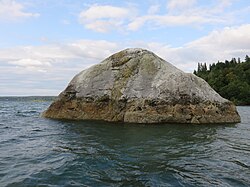List of boulders
| Frog Rock , dynamited, moved off the road, and stacked in 20th century |  |
| Haleets , at Agate Point on Bainbridge Island, has petroglyphs said to be from before 400 CE |  |
| Illahee Preserve erratic At Illahee Preserve Almira parking lot [2] | |
| Illahee Road erratic, an "extremely large erratic of volcanic rock" [3] | |
| Lone Rock, the namesake landmark of the unincorporated community of Lone Rock, located on the Hood Canal tidal flat about 400 feet off shore. At least 50 feet (15 m) across. [4] |  |
